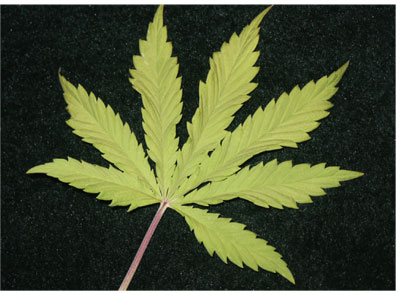
Hey, Doc, the patient asks quietly, after ensuring that no one else is listening. Can smoking pot really help your eyes?
If only we had a dollar for every time weve fielded THAT question. But, all joking aside, we cannot easily dismiss this issue. As primary eye care providers, we must educate our patients about ocular health issues, no matter how unusual or self-serving their questions may be.
Recreational use of marijuana is a criminal offense in 38 states and a misdemeanor in the other 12. This aside, is there any significant ocular benefit to using it? A review of available research may help us answer this question.

Medical Marijuana
The potential medicinal value of Cannabis sativa, a.k.a. the marijuana plant, has been known for nearly four millenia.1-3
Today, we recognize that the cannabinoidscannabinol, cannabidiol and delta-9-tetrahydrocannabinol (THC)are the compounds responsible for marijuanas neurogenic and psychotropic effects. These agents likely stimulate specific dopamine receptors in the central nervous system, resulting in various psychological and physiological alterations. The most well-known effect of marijuana: an induced state of euphoria or relaxation.3 Other theorized actions include increased fluidity of cell membranes, alteration of neurotransmitters, alteration of prostaglandins and inhibition of calcium uptake by synaptosomes.3
Marijuana use involves smoking the dried leaves and flowers of the plant, which contain high concentrations of cannabinoids. Individuals may also ingest the plant or brew and drink the leaves in a tea-like beverage. Rarely, the THC may be chemically concentrated and injected intravenously. For medical purposes, nebulizers that heat (but do not burn) the marijuana are available; they isolate and deliver the desired cannabinoids without the respiratory risks associated with smoking.
Scientists have produced a synthetic version of THC, which is available as a 2.5mg, 5mg or 10mg capsule under the trade name Marinol (dronabinol, Solvay Pharmaceuticals). This medication, available in the
Marijuana and Glaucoma
Since 1971, many studies have concluded that the active agents in marijuana are able to lower intraocular pressure (IOP) in normal subjects and glaucoma patients.5-9 This probably occurs via direct stimulation of ocular cannabinoid receptors, but definitive evidence is lacking.10,11 In a small study (n=11), researchers noted a prompt 25% to 30% IOP reduction in 82% of subjects who smoked marijuana.5 But, the duration of action in these subjects was only three to four hours. By contrast, a single dose of todays prostaglandin analogs may demonstrate IOP-lowering activity up to 84 hours.12 So, marijuana is simply not an efficient glaucoma medicine.
Cancer AIDS Alzheimers disease Multiple sclerosis Tourettes syndrome Parkinsons disease Management of spasticity, tics, convulsions and dyskinesias Surgery Trauma Management of pain
Proposed Medical Applications of Marijuana
Diagnosis
Effect
Anti-emesis, appetite stimulation
Also, there are local and systemic side effects associated with marijuana use. These include conjunctival hyperemia, diminished tear production (leading to dry eye), pupillary mydriasis, alteration of blood pressure and cardiac arrhythmias.13,14 Moreover, the psychotropic effects limit the use of this agent as a viable medical therapy. Besides euphoria, subjects have been found to experience disruption of short-term memory, cognitive impairment, a sense of time distortion, reduced motor coordination and sleepiness.13
Studies utilizing oral preparations of THC and other cannabinoids have shown a similar IOP-lowering effect with comparable limitations.15 Attempts to develop a marijuana-based eye drop are few; the hydrophobic/ lipophilic cannabinoids are insoluble in water. Experimental ophthalmic preparations typically use mineral oils as the carrier, though these agents can be extremely irritating. A 1983 study found no statistical difference between topical 1% THC and a placebo drop in lowering intraocular pressure when used q.i.d.16 Also, 18% of subjects had to leave the study due to burning, stinging and eyelid swelling.
To date, no topical marijuana derivative has been approved for glaucoma therapy in the
A 2003 report in a Jamaican newspaper suggests that a combination of Canasol and timolol, tentatively named Cantimol, is being developed by Ampec Chemicals. But, there is no confirmation that this drug has yet been approved by the Jamaican Ministry of Health.18
The Bottom Line
What can we tell patients who ask about marijuana use as a glaucoma treatment? Perhaps the most precise answer is this:
Organizations such as the
No studies have been published regarding the long-term ocular and systemic effects of marijuana use by glaucoma patients.
The duration of action of smoked marijuana necessitates frequent use (four to six times daily), which is impractical.
The psychogenic effects of regular marijuana use have been shown to hinder daily activity.
Also, smoking any substance is medically unwise; it predisposes individuals to respiratory ailments, such as emphysema, chronic obstructive pulmonary disease and lung cancer. Patients should understand the risks of acquiring street marijuana, as the purity of the drug may vary.
While the marijuana plant may offer significant therapeutic benefit, its role in glaucoma management is exceedingly small. Factor in the intangibles of procuring and using illegally grown and distributed products, and the use of marijuana becomes downright dangerous. So, when a patient asks about marijuana use, to quote former First Lady Nancy Reagan, Just say no.
Drs. Sowka and Kabat are full-time faculty members at Nova Southeastern University College of Optometry.
1. Di Marzo V, Petrocellis LD. Plant, synthetic, and endogenous cannabinoids in medicine. Annu Rev Med 2006; 57:553-74.
2. Russo E. History of cannabis as a medicine. In: Guy GW, Whittle BA, Robson PJ, eds. The Medicinal Uses of Cannabis and Cannabinoids.
3. Hubbard JR, Franco SE, Onaivi ES. Marijuana: medical implications. Am Fam Physician 1999 Dec;60(9):2583-8, 2593.
4. Solvay Pharmaceuticals, Inc. Marinol package insert.
5. Hepler RS, Frank IR. Marihuana smoking and intraocular pressure. JAMA 1971 Sept;217(10):1392.
6. Hepler RS, Petrus RJ. Experiences with administration of marihuana to glaucoma patients. In: Cohen S, Stillman RC, eds. The Therapeutic Potential of Marihuana.
7. Flom MC, Adams AJ, Jones RT. Marijuana smoking and reduced pressure in human eyes: drug action or epiphenomenon? Invest Ophthalmol 1975 Jan;14:52-5.
8. Merritt JC, Crawford WJ, Alexander PC, et al. Effect of marihuana on intraocular and blood pressure in glaucoma. Ophthalmology 1980 Mar;787:222-8.
9. Cooler P, Gregg JM. Effect of delta-9-tetrahydrocannabinol on intraocular pressure in humans. South Med J 1977 Aug;70(8):951-4.
10. Jarvinen T, Pate DW, Laine K. Cannabinoids in the treatment of glaucoma. Pharmacol Ther 2002 Aug;95(2):203-20.
11. Straiker A, Maguire C, Makie K, et al. Localization of cannabinoid CB1 receptors in the human anterior eye and retina. Invest Ophthalmol Visual Sci 1999 Sept;40(10):2442-8.
12. Dubiner HB, Sircy MD, Landry T, et al. Comparison of the diurnal ocular hypotensive efficacy of travoprost and latanoprost over a 44-hour period in patients with elevated intraocular pressure. Clin Ther 2004 Jan;26(1):84-91.
13. Tomida I, Pertwee RG, Azuara-Blanco A. Cannabinoids and glaucoma. Br J Ophthalmol 2004 May;88(5):708-13.
14. Fisher BA, Ghuran A, Vadamalai V, Antonios TF. Cardiovascular complications induced by cannabis smoking: a case report and review of the literature. Emerg Med J 2005 Sept;22(9):679-80.
15. Merritt JC, McKinnon S, Amstrong JR, et al. Oral delta 9-tetrahydrocannabinol in heterogeneous glaucomas. Ann Ophthalmol 1980;12(8):947-50.
16. Jay WM, Green K. Multiple-drop study of topically applied 1% delta 9-tetrahydrocannabinol in human eyes. Arch Ophthalmol 1983 Apr;101(4):591-3.
17. West ME, Homi J. Cannabis as a medicine. Br J Anaesth 1996 Jan;76(1):167.
18. Evans T. (2003). Ganja-based eyedrops a hot sell.
19.
20. National Eye Institute, National Institutes of Health. NEI Statement: The use of marijuana for glaucoma.

